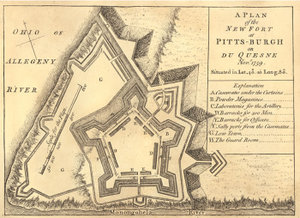January 29, 2007
What A Pitty

Pittburgh has buried the last bastion of Fort Pitt, the original British installation on the grounds where the city now stands:
Fort Pitt, named for the prime minister who led England to its victory in the Seven Years’ War (1755-1763), was the biggest and most expensive fortress on the frontier. Constructed after British troops drove the French from the western frontier in 1758, it stood at the forks of the two rivers that formed the Ohio, a show of force to French and Indians alike that England ruled the continent.As part of Pittsburgh’s efforts to replace more than a century of industrial dirt and decay with a riverfront park, one of the fort’s five bastions and part of its moat were recreated in the 1960s using some of the original bricks and cornerstones salvaged from the ruins. Called “the Music Bastion,” because it had been used by buglers, the structure was the first evidence to park visitors of the area’s historical significance.
“Its size . . . gives a sense of the sheer physical authority the wilderness outpost must have conveyed,” Barringer Fifield wrote in his 1996 book, Seeing Pittsburgh. The bastion and moat filled most of Point State Park’s acreage nearest the city. The bulk of the park’s 18 acres lies beyond Pittsburgh’s primary highway interchange and is accessible primarily by a pedestrian underpass. The remnants of the fort were seen as an obstacle to using the city side of the park for recreational activities.
To address that concern, the $35-million renovation of the park that started in December is covering and filling the bastion and moat to create a wide lawn for stage events. The region’s Riverlife Task Force devised the park’s upgrading plan as part of its effort to beautify the area’s riverbanks. Despite pleas and legal threats from local preservationists, the Commonwealth of Pennsylvania continues to press ahead with the burial. The state’s department of Conservation and Natural Resources promises that the contractors are covering the bastion and moat in a way that will preserve them so they can be excavated in the future.
The article goes on to quote Fred Anderson, about whose book on the Seven Years War, Crucible of War, I've enthused before:
Anderson, a professor of history at the University of Colorado, calls Fort Pitt “an absolutely crucial projection of imperial power. There was nothing like it in terms of size and military strength under British rule west of the Appalachians. Burying what’s left of it is a sad surprise.” He considers the burial “a mistake to do right now, just as the city was nearing its 250th anniversary. I’m staggered and puzzled by it. There will be nothing visible to give people a clue about the historical importance of Pittsburgh.”
Actually, I see the whole thing as a perfect metaphor for the way this country treats its colonial history. The average 'Murican, confronted with the names of Wolfe, Montcalm, Amherst, Braddock, Pontiac, William Johnson and others, will respond with a puzzled "Huh?" This is because nobody bothers to teach about them anymore.
And yet, it is literally impossible to understand the Revolution, and the motivations of people such as Adams, Revere, Franklin, Washington and Farmer George himself without understanding the events that lead up to it. In my more cynical moments, I'm convinced that this is a deliberate plot on the part of those who would make George III a comic book villain and the Founding Fathers comic book heroes. Whether the motivation behind such behavior is the desire to sugar-coat the Nation's founding or whether it's simply easier to teach it this way, I leave up to others.
Yips! to Rachel.
There are some of us who still remember. Having grown up a stone's throw from both Ft. Frederick and Braddock Heights, I would have immediately recognized those names even as a pre-teen. I think that my first school trip to Ft. Frederick was in 2nd grade. I hope that the school system back there is still keeping that history alive.
On the other hand, I'm not that hopeful that educators themselves see the importance of history anymore. I recently read a blog entry by an Oberlin senior who was ranting about monuments to Confederates at Antietam - that is after the imbecile was told (and he had to be told - he honestly didn't know) what the initials "CSA" stood for. As someone whose ancestors fought under both the USA and CSA banners, my only comment was "shut up".
A college senior in the liberal arts who knows that little of history is going to grow up to be a parks administrator who paves over Ft. Pitt.
Posted by: John at January 29, 2007 05:27 PMBurying our real history makes it easier to fabricate a revisionist version.
Is that not obvious?
Posted by: Hucbald at January 29, 2007 11:10 PMI grew up near Pittsburgh, so I'm glad I saw what remained of the fort when I had a chance. Damn shame. Gee, whats next? Tear down Fort Necessity for condos??
Have you ever driven Rt.40 in Pa?? It takes you past Ft. Necessity. There is a memorial for Gen. Braddock too. Jumonville is worth checking out. Oops, sorry, I'm starting to sound like the PA Tourism bureau.
Posted by: Stillers at January 30, 2007 04:48 AMThis is why I give so much money to Civil War preservation.
Husband likes to plan our vacations around stopping at such places at Ft. Necessity and the like.
*sigh*
Looks like there won't be too much for us history buffs to see anymore, and even less for our kids!
Posted by: GroovyVic at January 30, 2007 06:51 AM

 Image courtesy of the lovely and talented
Image courtesy of the lovely and talented 